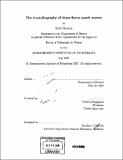| dc.contributor.advisor | Krishna Rajagopal. | en_US |
| dc.contributor.author | Sharma, Rishi, Ph. D. Massachusetts Institute of Technology | en_US |
| dc.contributor.other | Massachusetts Institute of Technology. Dept. of Physics. | en_US |
| dc.date.accessioned | 2009-04-29T17:35:09Z | |
| dc.date.available | 2009-04-29T17:35:09Z | |
| dc.date.copyright | 2007 | en_US |
| dc.date.issued | 2007 | en_US |
| dc.identifier.uri | http://hdl.handle.net/1721.1/45393 | |
| dc.description | Thesis (Ph. D.)--Massachusetts Institute of Technology, Dept. of Physics, 2007. | en_US |
| dc.description | Includes bibliographical references (p. 197-209). | en_US |
| dc.description.abstract | The nature of cold three-flavor quark matter at the large (but not asymptotic) densities relevant to neutron star phenomenology is not resolved. The gapless CFL phase, which was previously believed to have the lowest free energy, was recently shown to be unstable in the sense that some phase must have lower free energy. The nature of the instability motivates the hypothesis that the stable phase is a crystalline color superconductor. In this thesis, we present the calculation of the free energies of three-flavor crystalline color superconductors for realistic crystal structures in the Ginzburg-Landau approximation. All previous work on this subject neglected the strange quarks; we include them, with qualitative consequences. We calculate free energies for many crystal structures, and find two (based upon cubic symmetry) that have lower free energy than the gapless CFL phase over the lower density half of the relevant parameter space. They are therefore good candidates for the phase quark matter exists in, if it is present in the cores of neutron stars. We investigate the implications of the existence of a crystalline color superconducting core on the phenomenology of glitches in neutron stars. The key ingredient in the standard explanation of the origin of glitches is the presence of a rigid lattice in a superfluid medium which provides sites where vortices in the superfluid can be pinned, a situation that exists in the inner crust of the neutron stars. By deriving the effective action of the phonons in the crystalline phases, we determine that these are very rigid, with a shear modulus 20 to 1000 times larger than that of neutron star crusts. They are at the same time superfluid and a rough estimate of the pinning force on vortices gives answers comparable to that for pinning in the inner crust. This raises the possibility that (some) glitches could originate in quark matter cores of neutron stars. | en_US |
| dc.description.statementofresponsibility | by Rishi Sharma. | en_US |
| dc.format.extent | 209 p. | en_US |
| dc.language.iso | eng | en_US |
| dc.publisher | Massachusetts Institute of Technology | en_US |
| dc.rights | M.I.T. theses are protected by
copyright. They may be viewed from this source for any purpose, but
reproduction or distribution in any format is prohibited without written
permission. See provided URL for inquiries about permission. | en_US |
| dc.rights.uri | http://dspace.mit.edu/handle/1721.1/7582 | en_US |
| dc.subject | Physics. | en_US |
| dc.title | The crystallography of three flavor quark matter | en_US |
| dc.title.alternative | Crystallography of 3 flavor quark matter | en_US |
| dc.type | Thesis | en_US |
| dc.description.degree | Ph.D. | en_US |
| dc.contributor.department | Massachusetts Institute of Technology. Department of Physics | |
| dc.identifier.oclc | 317403907 | en_US |
